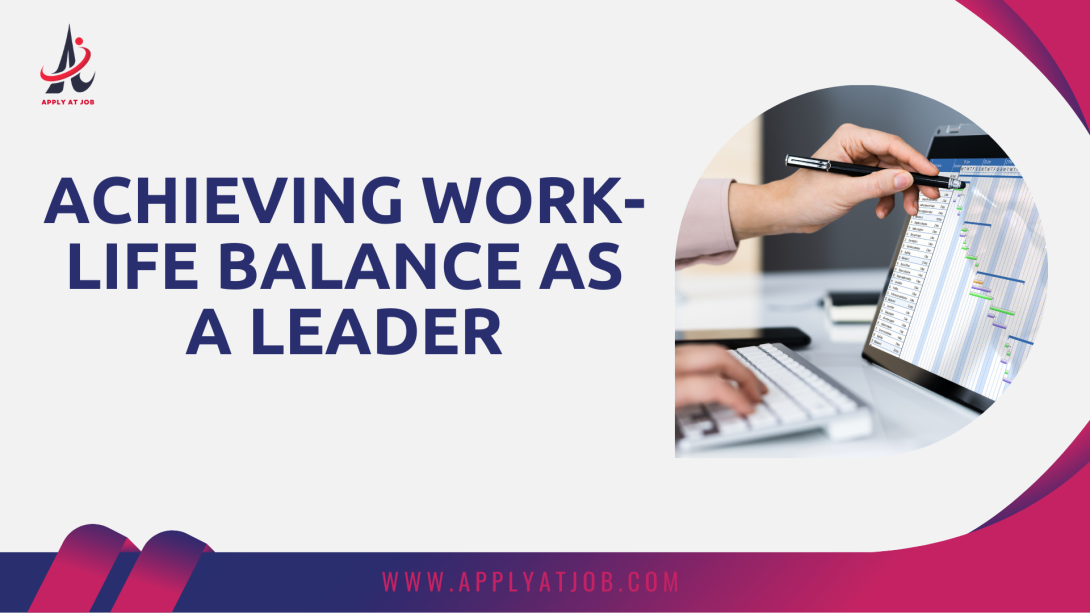
Being a Leader and Achieving Work-Life Balance
It can be difficult to strike a balance between work and life, particularly for leaders who have heavy workloads and important responsibilities. However, maintaining motivation, preventing burnout, and leading by example are all dependent on striking this balance. We'll look at ways to assist leaders successfully manage their work-life balance in this blog so they may lead with purpose, vigor, and clarity.
1. Clearly define your work and personal time boundaries.
Setting limits is one of the best strategies to attain work-life balance. Although leaders frequently deal with requests outside of regular business hours, setting clear boundaries between work and personal time can help keep work from taking over.
. Establish "Office Hours": Leaders may prevent working overtime by establishing defined start and finish periods for their workdays. Notify your teammates of your availability and urge them to follow these limits as well.
. Turn Off alerts: To reduce disruptions and allow yourself time to unwind and rejuvenate, think about turning off work alerts after hours.
2. Set Value-Based Time Priorities
The most important resource for a leader is time, which must be managed carefully. Leaders may increase productivity without compromising their personal time by setting priorities for work according to their importance and urgency.
. Determine High-Value Activities: Give special attention to projects that advance your leadership development or directly contribute to the success of the company. Assign repetitive or low-value tasks to team members who are qualified to complete them.
. Make Use of Time-Management Resources: Leaders can maintain organization, meet deadlines, and efficiently manage their time with the use of calendar applications, to-do lists, and project management tools.
For instance, a time-management tool called the Eisenhower Matrix can assist leaders in prioritizing important tasks over less significant ones by helping them group jobs according to their significance and urgency.
3. Develop Effective Delegation Skills
One effective strategy for CEOs looking to strike a work-life balance is delegation. Leaders may free up time to concentrate on higher-level duties and provide opportunity for others to grow by delegating chores to competent team members.
. Determine the Most Important Delegation Areas: Determine which jobs may be assigned without sacrificing quality. Daily operations, regular reporting, or project tracking may fall under this category.
. Empower Your Team: Give team members the tools they need to succeed as well as clear direction. Increasing team trust not only lessens your burden but also improves the team's performance.
For instance, a lot of effective leaders attribute their ability to manage work and personal obligations to delegating. They may concentrate on strategic goals by giving their staff the freedom to assume responsibility for tasks.
4. Consistently Take Care of Yourself
Leaders who put their health and wellbeing first are better able to manage the responsibilities of their position. Leaders who take care of themselves are better able to stay focused, make wise judgments, and feel less stressed.
. Physical Health: Both mental clarity and physical resilience can benefit from regular exercise, enough sleep, and a balanced diet.
. Mental Health: Engaging in mindfulness exercises, meditation, or even just spending time with loved ones might help you focus better and feel less stressed. Every day, set aside a little period of time to relax and engage in activities that promote self-recharge.
5. Establish a Flexible Timetable
Work-life balance may be considerably improved with flexible work schedules. You may more successfully fulfill commitments on both fronts by modifying your schedule to fit both professional and personal objectives.
. Establish Peak Productivity periods: Determine the hours of the day when you are most productive and set aside these periods for projects requiring a high level of attention. during instance, plan important activities or meetings during the morning if that's when you're most productive.
. Include Rest Periods Throughout Your Day: By taking little pauses throughout the day, you can maintain your attention and rejuvenate. Burnout may be avoided and you can resume duties with more vigor if you take regular pauses.
For instance, in order to sustain high levels of production while managing energy, some leaders employ the Pomodoro Technique, which entails working in concentrated intervals (such as 25 minutes) interspersed with brief pauses.
In conclusion, effective leadership requires balance.
In addition to being good for your own health, achieving work-life balance as a leader boosts team morale and productivity. Setting limits, assigning tasks efficiently, and putting self-care first foster an atmosphere that supports both professional and personal success. The key to juggling work and life is to be intentional with your time and energy and concentrate on the things that are most important. A healthier, more sustainable, and more productive workplace is created for all employees when leaders take action to attain work-life balance.
You can visit our site: Applyatjob.com
https://applyatjob.com/hiring-employee
https://applyatjob.com/jobs




